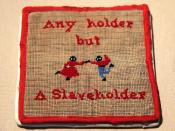In the early 19th century the legitimacy of the rights of women as well as slaves were being questioned. Not only their actual rights as separate groups, but the ability of women to participate in the abolition movement was in dispute as well . Many letters can be found as to how the women felt regarding such debates, these letters date back to around 1837-1838. Two of these infamous letters in particular, when examined, are able to sum up the views of women from this time. When compared and contrasted, Legal Disabilities of Women, and A Letter to The Liberator exemplify the feelings and emotions portrayed by the devoted women involved with the movement. The parallelism of the two documents concerning women's rights, and the involvement of women is abolitionism is easily recognized and can be examined to a further extent..
Sarah M. Grimke can be noted as a radical from this particular era of time.
She was one of the main enforcers of the Women's right's movement. In her letter to her sister her determined attitude is shown at its fullest extent. This letter is dated September 6, 1837, and basically slanders the legitimacy of the contract of marriage. Grimke states how women's rights are essentially taken away once she is married. Women have no representation in government and are all in all treated on the level of a slave. Once married, the husband takes on the role of master, and the wife is expected to follow through with any chores he desires or commands. Instead of the assets being combined after marriage, the husband gains the wife's property, and she is merely privileged enough to share them with him. "Yet a man may spend the property he has acquired by marriage at the ale-house, the gambling...


